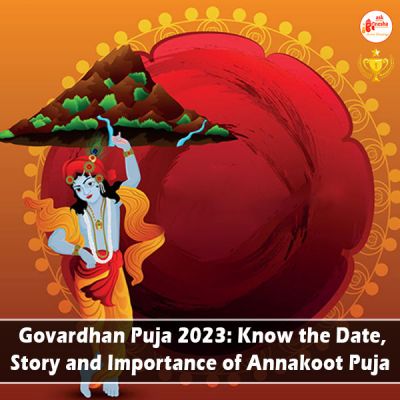The tapestry of Hindu festivals is vibrant, lively and energetic, holding a special place. One such festive event brimming with devotion, blessings and endless celebrations is Govardhan Puja, marking the victory of faith and humility over pride and arrogance.
It is primarily a part of wider Diwali celebrations carrying unique astrological significance. Let’s delve deeper into the astrological insights of Govardhan Puja and its auspiciousness that is set to take place this year.
History and Mythology – The Ancient Perspective
Govardhan Puja, also known as the Annakut Puja, is celebrated on the first lunar day of the Hindu calendar month of Kartik, falling in October or November. It is rooted in the ancient, revered Hindu epic, Bhagavad Geeta, where Lord Krishna showcased his divine power by lifting the Govardhan Parbat (Mountain) to shield the beings of Vrindavan against the wrath of Lord Indra.
What Astrology Has to Say – Govardhan Puja from the Lens of Astrology
1. Seasonal Transitioning
This Govardhan Puja is set to take place during the harvest season when farmers are reaping the rewards of the hard work and labour they have put into growing the sustainable eatables of all humanity. In the astrological context, this transition period from rainy to harvesting signifies a healthy change and transformation that can entirely change the meaning of existence. This is when humans, too, can invite some healthy changes in their lives and kick all the past baggage they live with.
2. Lord Krishna’s Power and Blessings
Hindu astrology connects Lord Krishna with the planet Mercury, which symbolizes intelligence, communication and utter diplomacy. Celebrations of Govardhan Puja are a way of seeking blessings from the almighty and invoking all of the qualities connected with Mercury, the planet of Lord Krishna. This Puja is highly auspicious for people seeking personal growth, a better existence and never-ending success.
3. Muhurat Connections
Muhurat in Hindu Mythology and theories holds a very special place and meaning owing to the auspicious period it attached to itself. From festivities to weddings, the importance of Muhurat can always be maintained in the Hindu Tapestry. It plays a crucial role in the realms of Vedic astrology, too. This Govardhan Puja is held and celebrated during a specific Muhurat to align the planets' energies so that every ritual benefit is maximized. As per astrology, this period marks success and auspiciousness for initiating new ventures, and spiritual enlightenment is at its peak.
4. Lunar Cycle
This festival of Govardhan Puja occurs on the first lunar day of Kartik. It emphasizes the significance of the influence of the Moon in astro practices. Talking of lunar phases and their impact, it is highly believed to impact the emotions, mind and heart. Celebrations of Govardhan Puja during this period are thought to attract balance, harmony and happiness in one’s personal and professional life. It marks balance and stability in human emotions and overall wellness.
Astrological Practices for Govardhan Puja
1. Prayers and Meditation
Govardhan Puja, among the many Hindu festivals, it is a perfect time to mark new beginnings and auspiciousness. Meditation and prayers during this time signal growth, inner peace and happiness. It is believed that the mind during this period is more receptive to positivity and energies. It attracts growth and prosperity from wherever possible.
2. Offerings and Rituals
We all are capable of feeding ourselves, but once in a while, during festivities; the Lord gives us a chance to spread positivity and wellness to those who are in dire need of it. Govardhan Puja is the epitome of auspiciousness and happiness, and sharing this happiness with others multiplies the blessings and rewards attached to this Puja. Devotees often make offerings of foods in the form of a mountain of dishes, symbolizing the Govardhan Parbat. This practice or act is marked as an offering to Lord Krishna and deities for utmost protection, blessings, wealth, prosperity and happiness.
3. Seeking Blessings for Prosperity and Happiness
In the astrological context, this period is favourable to seek blessings for success, wealth, prosperity and abundance. As you perform all the rituals with utter dedication and devotion, you can align yourself with planetary energies for your financial, mental and physical well-being. This festival is a sign of new beginnings for people who desire positivity and betterment in their lives.
The Rituals and Traditions of Govardhan Puja
1. Annakut Preparation
Devotees always have a large menu and prepare a grand feast, which is known as Annakut, composed of a variety of vegetarian dishes. These dishes are then arranged meticulously in the form of a mountain to symbolize the Govardhan Parbat. The astrological significance highlights the importance of harmony and abundance in the balance of nature.
2. Diya Lighting
Lighting Diyas or oil lamps is a very common practice during the Govardhan Puja period. This act has a very prosperous astrological meaning that signifies the dispelling of darkness and welcoming light and positivity in life. In the context of Vedic astrology, light is associated with enlightenment and thought clarity. Lighting of Diyas is marked as an act of inviting and welcoming good days in life and letting go of all the negativities and hurdles of life.
3. The Govardhan Parikrama
Another important practice during the Govardhan Puja is the act of circumambulation, or what we call the Govardhan Parikrama, around an image or an idol representing the Govardhan Hill. This ritual is often connected with the spiritual and cosmic journey that aligns with the astrological belief in walking around sacred objects to absorb their divine energies and blessings.
Get a Detailed Remedial Consultancy Report today
Conclusion
Govardhan Puja is one of the most auspicious periods, blending seamlessly with astrological beliefs and spiritual practices. This period is a unique occasion for personal growth, self-enlightenment, abundance and prosperity. It invites positivity and newness in the mundane circle of life. The rituals connected to this festival are not just spiritually significant but also are deeply rooted in the wisdom of astrology. It is a beautiful reminder of a holistic approach to life being prevalent in the Hindu culture.





















 Translate
Translate